A Blast from the Past: Wood Floors in the 1800’s
Not too long ago as I was researching information on hardwood floors and finishes during the 1800’s in North America when I stumbled upon a great online library that had thousands of old books, periodicals, catalogues, postcards, brochures and photos… amongst other cool things from that era.
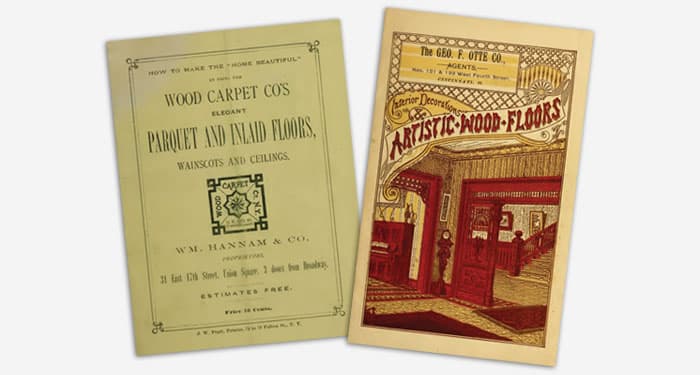
I was pretty excited when I came across some old trade brochures for wood floors from the late 1800’s to the early 1920’s. I thought it would be fun to feature them on our blog to see what’s changed over the years and what information about hardwood floors is still relevant.
When you look through these two brochures it’s pretty obvious that these intricate parquet floors, medallions and borders were being marketed to the wealthy homeowners of those days.
Look at some of the beautiful designs they had to choose from…
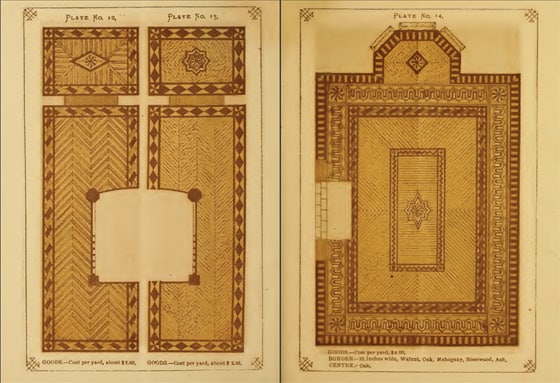
Here’s a small sample of the choices of borders available…
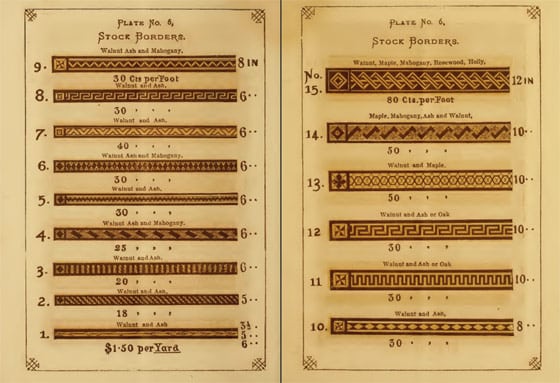
What amazing patterns and designs, with beautiful wood selections to choose from like Walnut, Mahogany, Rosewood, Maple, Ash and Oak.
And have a look at those prices. How much do you think they would go for today? A lot more than 30 cents per foot that’s for sure… that’s if you could even find them. I’m sure in those days these were quite pricey too if you included installation and finishing.
Here are some even more ornate borders…
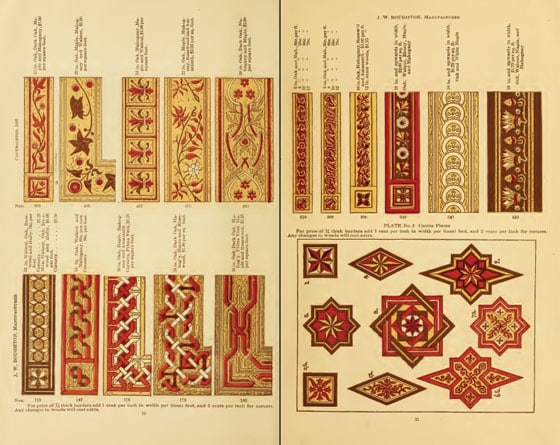
Look at the beautiful stair work you could have installed in your home back then…
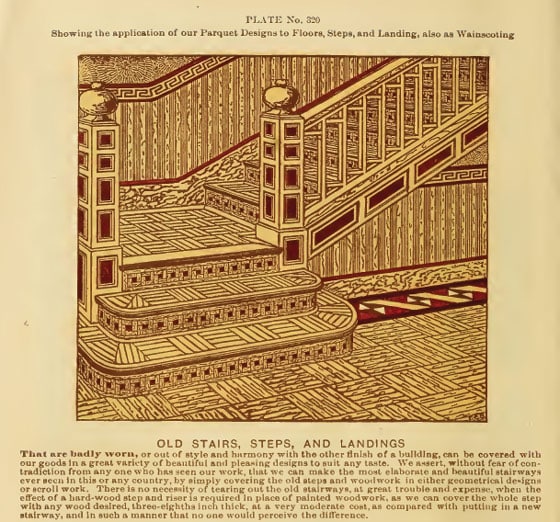
I’m not sure how good your eyesight is and if you can read the write-up in the picture above but it seems like this was the ‘laminate’ type flooring option back then… used to cover up older worn out wood floors without ripping them out. But this type of parquet was far from ‘cheap and nasty’… it’s still around and in use in these older houses to this very day. I’d love to see what the laminate floors of our generation look like in 120 years.
Imagine tearing out the carpet from an old set of stairs and discovering something like the picture above. Now that would be a find!
In one of the brochures was some interesting information about the history of wood floors and carpets…
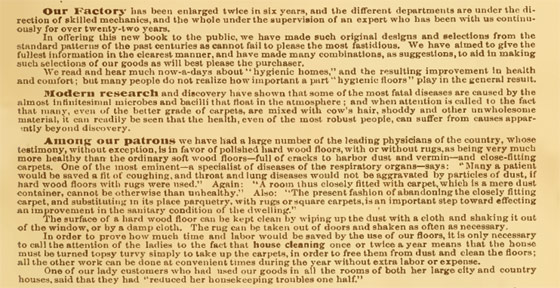
It seems like there’s been a long time dispute between carpet lovers and hardwood floor enthusiasts.
The article mentions how… “a large number of the leading physicians of the country, is in favor of polished hard wood floors as being very much more healthy than… carpets”, and that… “when attention is called to the fact that many, even of the better grade of carpets are mixed with cow’s hair, shoddy and other unwholesome material, it can readily be seen that the health, even of the most robust people, can suffer from causes apparently beyond discovery.”
It continues with… “the present fashion of abandoning the closely fitting carpet, and substituting in its place parquetry, with rugs or square carpets, is an important step toward effecting an improvement in the sanitary condition of the dwelling.”
I’m sure carpets aren’t made with “cow’s hair” today but they still are huge dust collectors and can be very unhealthy if not continually cleaned, and even then not all the ground in dirt and dust can be completely removed. Not much has changed in that regard over the years.
If carpets are so bad though, how come they became very popular again in the 1950’s?
Maybe the following section of the parquet brochure lends a clue…

Imagine having to wax and polish your wood floors by hand with the polishing brush above – that’s a lot of hard work. There were no electric buffers in those days.
Plus when you had to re-wax them you would have to wash the floor thoroughly with turpentine before applying a fresh coat of wax. Can you imagine how much of a stench – not to mention the danger – that would cause!
People were starting to get tired and weary of all the maintenance hardwood floors needed.
Then… along came the industrial revolution in the 50’s and the availability, quality and selection of carpet shot through the roof and the price lowered dramatically. Vacuuming seemed to be way easier than spending hours buffing on wax… even though by this time electric buffers were available.
What was not to love about this ‘new’ soft, plush floor covering?
(As long as we conveniently forget the health aspects. It would be many years before they would have to be replaced and the later generations would see the gunk that was hiding in and underneath them – yuck.)
And so during this period, hundreds of thousands of hardwood floors were covered – we like to think protected – with this “new” revolutionary floor covering.
(Here’s an interesting write-up of the history of carpet we found on another blog if you’d like more info on this.)
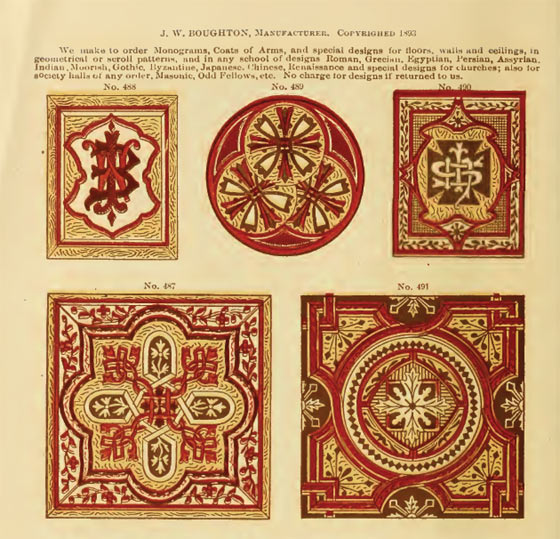
As you can see there is lots of very interesting information and flooring history in these old wood flooring brochures.
It’s fun to see how the flooring industry has advanced – and sometimes regressed – over the last 150 or so years.
One thing we can see is that while floor coverings, finishes and processes will always be in a constant state of change (and price has and always will be a huge factor), the basics of the real wood flooring industry has remained the same for a long time and will continue to do so into the future.
Many of these beautiful old solid wood floors that were installed all those years ago are still in daily use and have years of life left in them!
There’s no way our children’s kids will be saying that about our ‘modern advancements’ with carpet and laminate floors 120 years down the road.
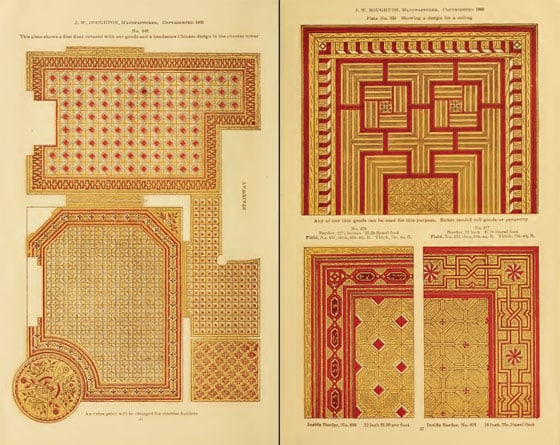
We have to remember too that while our popular wood floors today may not be as ornate as some of these extravagant pictures… most of the ‘common’ folk back then had simple strip hardwood floors or plain parquet with simple strip borders, if any at all.
These are the most common types of floors we see being restored in our homes throughout the Naperville and Chicago area today.
Speaking of Chicago…
This trade catalogue from 1893 shows the exhibition that J.W. Boughton Manufacturing had on display right here in Chicago for the World’s Fair: Columbian Exposition. (You can read more about the 1893 Chicago World’s Fair here.)
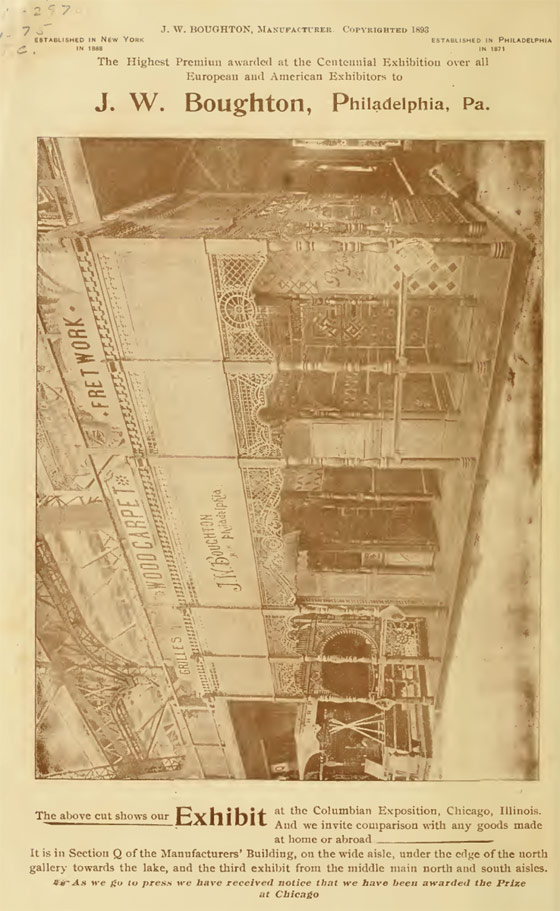
The intricate work in this trade booth display is incredible. I would have loved to see this in person.
You don’t see this level of craftsmanship in trade show booths today that’s for sure. At the bottom of the page you can see that they were even awarded the Prize at Chicago for their exhibition.
Neat stuff hey.
In the next blog post I’ll show you 2 more old brochures and you’ll be able to see just how far hardwood floor finish systems have come since the 1800’s up to the early 1950’s.
Until then we hope your wood floor finishing project goes well. If you have any questions we’re happy to help answer them on our blog here or privately in an email.
–
Updated Jan 2023


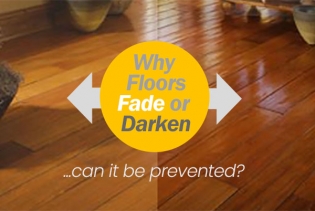
“it seems like this was the ‘laminate’ type flooring option back then… used to cover up older worn out wood floors without ripping them out”
It was a thick veneer on canvas backing – sometimes called “wood carpeting” meant to be unrolled onto your sound but unstylishly plain wood floors.
If you find it, it can be salvaged, but it’s tricky.
Hi Tsu,
Yes we’ve seen that old roll out “wood carpeting” too, cool stuff hey. Very hard to find these days though.
The product advertised in this image was 3/8″ thick though and used for covering whole floors as well as stair treads and landings. The field was a parquet pattern and there was dozens of border options available in the brochure. It would most likely have been glued down over the existing floor, so a bit different from wood carpet.
We’ve come across a few of these 3/8″ intricate floors glued over existing wood floors in some old homes here in Chicago. Unfortunately most of it is unsalvageable because it’s so thin after numerous sandings over the years. Shame because it is very nice stuff.
Tadas
What is the online source for these catalogs please?
Hi Paul,
I don’t have the exact link to each catalog in front of me but if you go to http://archive.org and type ‘Winterthur Museum’ you will be able to find them under the Trade Catalogs section.
Be careful though… you can end up spending hours looking through the huge list of things there :)
Tadas
Yes, what a wonderful find. I’m amazed at some of these intricate floors. We have been lucky enough to refinish several of them, and they are exquisite.
One from 1880 (and I believe on historic registry). Each room had a big fireplace and a different border of maple/cherry/walnut. They were 3/8″. It was definitely challenging to refinish as it was thin.
More often than not, we have seen these types of floors nailed in (not glued).
I have never seen them on the steps. I’m guessing that was really challenging to do because almost all the steps that we see from the 1800’s and 1700’s are very uneven and creaky. Carpet runners would probably be much more practical (and certainly that’s what we see now.
One of the benefits of living in NY is that we have some very old homes…that still exist. The oldest we did was from 1726. Of course, back then is was softer wider plank pines, often with face nails. The one we did from 1726 was probably 1.5 to 2″ thick…and I’m sure it had been refinished before us. Amazing.
Those floors sound awesome Debbie. It’s definitely a treat working on historic floors.
Tadas
Mom my works at the French County Inn near Lake Geneva Wi, that has on original structure from the world fair with original woodwork and flooring similar to the first page listed. I have seen similar flooring in couple of older building in the area and always wondered about the original craftsman who was here. Thanks for the info!
Wow Christa, that’s very cool.
Tadas
Hi Tadas,
We bought a house built in the 1800s in Australia a couple of months ago and uncovered a floor that looks like the wood carpeting shown in this blog. Can I send you pictures to get your opinion on whether it is or not?
Hi Dafne,
Sure. Happy to take a look. You can send it to tadas [at] napervillehardwood.com
Just place a link to this post so I remember who you are :)
Tadas
We are wondering about the wood floors in a 1927 Craftsman in Milwaukee. Most of the floors are red oak, but the kitchen is maple. It had linoleum over it which, we removed. Was this a common practice? My husband thinks maybe the oak was added later, but it makes up the bulk of the house, and all the woodwork is oak. The Maple in the kitchen has a lot of marks from previous stoves, etc, so it looks like it, too, was original.
Hi Rebecca,
Yes having different types of wood was very common. Usually the cheaper more common wood was used in kitchens, lofts, staircases etc. where they would have been either covered or not seen much. Oak would have been used in the common areas like your house.
Tadas
I have a house built in the late 1800s. I thought I had some large joint cracks in the flooring. When I removed a piece, I saw that the construction of the planks actually had an “overlap” on one side and an “underlap” on the other side. It almost seems like a precursor to tongue and groove. Do you have any information on this joint technique?
Also, I’m looking for a few replacement boards, any suggestions? I live in southern Virginia.
Really enjoyed your blog.
Hi Erm,
Thank you. Yes, this is called a half-lap joint. You most likely will have to get someone to custom mill the replacement boards for you as this isn’t a common wood flooring joint anymore.
Tadas